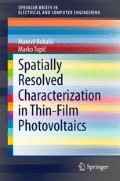Abstract
Dye-sensitised solar cells are presented as an example of third generation photovoltaic devices. Their structure and fabrication are described as required for understanding spatial inhomogeneities. Because light interaction takes place via dye molecules, the operation of dye-sensitised solar cells is explained together with the operation under an electroluminescence regime. Conversion efficiency inhomogeneities of dye-sensitised solar cells are distinguished between manufacturing, other and unknown inhomogeneities. Each inhomogeneity type is described by a specific fingerprint obtained using transmittance imaging, light beam induced current and electroluminescence measurements. Ageing studies of dye-sensitised solar cells using transmittance imaging and electroluminescence measurements represents another use of spatial characterisation techniques and reveals the dynamics of the iodine present in the electrolyte.
Access this chapter
Tax calculation will be finalised at checkout
Purchases are for personal use only
References
Grätzel M (2003) Dye-sensitized solar cells. J Photochem Photobiol C Photochem Rev 4:145–153. doi:10.1016/S1389-5567(03)00026-1
Asghar MI, Miettunen K, Halme J, Vahermaa P, Toivola M, Aitola K, Lund P (2010) Review of stability for advanced dye solar cells. Energ Environ Sci 3:418–426. doi:10.1039/b922801b
Hardin BE, Snaith HJ, McGehee MD (2012) The renaissance of dye-sensitized solar cells. Nat Photon 6:162–169. doi:10.1038/nphoton.2012.22
Kim H-S, Lee C-R, Im J-H, Lee K-B, Moehl T, Marchioro A, Moon S-J, Humphry-Baker R, Yum J-H, Moser JE, Grätzel M, Park N-G (2012) Lead iodide perovskite sensitized all-solid-state submicron thin film mesoscopic solar cell with efficiency exceeding 9 %. Sci Rep 2:591. doi:10.1038/srep00591
Lee MM, Teuscher J, Miyasaka T, Murakami TN, Snaith HJ (2012) Efficient hybrid solar cells based on meso-superstructured organometal halide perovskites. Science 338:643–647. doi:10.1126/science.1228604
Miettunen K, Halme J, Lund P (2009) Spatial distribution and decrease of dye solar cell performance induced by electrolyte filling. Electrochem Commun 11:25–27. doi:10.1016/j.elecom.2008.10.013
Scott MJ, Woodhouse M, Parkinson BA, Elliott CM (2008) Spatially resolved current-voltage measurements-evidence for nonuniform photocurrents in dye-sensitized solar cells. J Electrochem Soc 155:290–293. doi:10.1149/1.2830944
Jones TW, Feron K, Anderson KF, Duck BC, Wilson GJ (2014) An applied light-beam induced current study of dye-sensitised solar cells: photocurrent uniformity mapping and true photoactive area evaluation. J Appl Phys 116:043104. doi:10.1063/1.4890935
Navas FJ, Alcantara R, Fernandez-Lorenzo C, Martin J (2009) A methodology for improving laser beam induced current images of dye sensitized solar cells. Rev Sci Instrum 80:063102. doi:10.1063/1.3147381
Macht B, Turrión M, Barkschat A, Salvador P, Ellmer K, Tributsch H (2002) Patterns of efficiency and degradation in dye sensitization solar cells measured with imaging techniques. Sol Energ Mat Sol Cells 73:163–173. doi:10.1016/S0927-0248(01)00121-0
Bokalič M, Krašovec UO, Topič M (2013) Electroluminescence as a spatial characterisation technique for dye-sensitised solar cells. Prog Photovolt Res Appl 21:1176–1180. doi:10.1002/pip.2224
Wen-Bo X, Wei-Qing L, Xing-Dao H (2013) Analysis of electron recombination in dye sensitized solar cells based on the forward bias dependence of dark current and electroluminescence characterization. Chin Phys Lett 30:108801. doi:10.1088/0256-307X/30/10/108801
Kirchartz T, Mattheis J, Rau U (2008) Detailed balance theory of excitonic and bulk heterojunction solar cells. Phys Rev B 78:235320. doi:10.1103/PhysRevB.78.235320
Hočevar M, Berginc M, Topič M, Opara Krašovec U (2010) Sponge-like TiO2 layers for dye-sensitized solar cells. J Sol-Gel Sci Technol 53:647–654. doi:10.1007/s10971-009-2144-6
Opara Krašovec U, Berginc M, Hočevar M, Topič M (2009) Unique TiO2 paste for high efficiency dye-sensitized solar cells. Sol Energ Mat Sol Cells 93:379–381. doi:10.1016/j.solmat.2008.11.012
Solaronix—innovative solutions for solar professionals. http://www.solaronix.com/. Accessed 7 Aug 2014
Berginc M, Opara Krašovec U, Jankovec M, Topič M (2007) The effect of temperature on the performance of dye-sensitized solar cells based on a propyl-methyl-imidazolium iodide electrolyte. Sol Energ Mat Sol Cells 91:821–828. doi:10.1016/j.solmat.2007.02.001
Athanassov Y, Rotzinger FP, Péchy P, Grätzel M (1997) Sensitized electroluminescence on mesoporous oxide semiconductor films. J Phys Chem B 101:2558–2563. doi:10.1021/jp962192j
Trupke T, Würfel P, Uhlendorf I, Lauermann I (1999) Electroluminescence of the dye-sensitized solar cell. J Phys Chem B 103:1905–1910. doi:10.1021/jp982555a
Martinson ABF, Hamann TW, Pellin MJ, Hupp JT (2008) New architectures for dye-sensitized solar cells. Chem Eur J 14:4458–4467. doi:10.1002/chem.200701667
Rau U (2007) Reciprocity relation between photovoltaic quantum efficiency and electroluminescent emission of solar cells. Phys Rev B 76:085303. doi:10.1103/PhysRevB.76.085303
Opara Krašovec U, Bokalič M, Topič M (2013) Ageing of DSSC studied by electroluminescence and transmission imaging. Sol Energ Mat Sol Cells 117:67–72. doi:10.1016/j.solmat.2013.05.029
Berginc M, Opara Krašovec U, Topič M (2014) Outdoor ageing of the dye-sensitized solar cell under different operation regimes. Sol Energ Mat Sol Cells 120:491–499. doi:10.1016/j.solmat.2013.09.029
Berginc M, Topič M, Opara Krašovec U (2014) Recovery of dye-sensitized solar cell’s performance by heat treatment. Phys Chem Chem Phys 16:12940–12948. doi:10.1039/C4CP01463D
Author information
Authors and Affiliations
Corresponding author
Rights and permissions
Copyright information
© 2015 The Author(s)
About this chapter
Cite this chapter
Bokalič, M., Topič, M. (2015). Dye-Sensitised Solar Cells. In: Spatially Resolved Characterization in Thin-Film Photovoltaics. SpringerBriefs in Electrical and Computer Engineering. Springer, Cham. https://doi.org/10.1007/978-3-319-14651-5_6
Download citation
DOI: https://doi.org/10.1007/978-3-319-14651-5_6
Published:
Publisher Name: Springer, Cham
Print ISBN: 978-3-319-14650-8
Online ISBN: 978-3-319-14651-5
eBook Packages: EnergyEnergy (R0)

